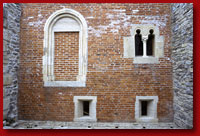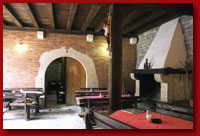 |
MEDVEDGRAD
- MONUMENT PRESERVATION AND POLITICS
History - Medvedgrad ('Bear-town`, in sources also called
Medwed, Medveduar, Medve) was built by Philip, Bishop of
Zagreb on the slopes of Medvednica Mountain above Zagreb
from 1249 to 1254. It was surrounded by a double ring of
defensive walls and flanked by two towers, northern and
southern. The most noteworthy building was the octagonal
Chapel of St. Philip and St. James. Medvedgrad changed
hands many times, in 1590, during the reign of the Counts
of Gregorijanec, the town was destroyed by an earthquake
and had to be abandoned. In 1642 it is already referred
to as a ruin. In 1979 the reconstruction of some parts
began. In 1993 intensive restoration and reconstruction
of Medvedgrad had begun in earnest, stimulated by plans
to erect an Altar of the Homeland at this medieval site.
Thus the time for restoration was extremely short, and
this resulted in careless work.
The Altar of the Homeland, situated below the southern
tower of Medvedgrad, was erected by Dr. Franjo Tudman President
of the Republic of Croatia on the Day of Statehood, on
May 30 1994 to commemorate Croatian heroes deceased in
the war against Serbia. To lay a wreath on the altar started
to be a state protocol: the high tower was meant to host
the exhibition of Croatian history; the palace was turned
into a presidential residence. Medvedgrad was closed to
visitors and soldiers were set to guard the “Altar.” This
new monument, executed by the sculptor Kuzma Kovačic aroused
great scandal, partly because of the high costs (ca. 500
000 euros) but also because of its ideological background.
The extremely short period of reconstruction was disastrous
both in terms of monument protection and quality. In 2000
the government of Croatia decided that the Altar of the
Homeland would no longer be a part of state protocol and
returned the site to its owner – the city of Zagreb. |
|
 |
 |
|
|
|
|
|
 |
RECONSTRUCTION
OF THE RENAISSANCE HERCULES FOUNTAIN IN THE PALACE OF
VISEGRÁD
Among the works commissioned by King Matthias two red marble
fountains were made for the palace of Visegrád, as described
by written sources. Only a few fragments found during excavations
are known from the so-called “Fountain of the Muses”. The
other fountain stood in the inner courtyard of the palace.
This latter fountain was pieced together from the finds
of archaeological excavations. Since the original base
of the fountain and numerous fragments of the fountain
itself were found, it was possible to make an authentic
reconstruction. The Hercules Fountain is the only surviving
example of the richest quattrocento fountain type consisting
of a basin and a fountain bowl. Significantly, this is
the first reliably dated monumental Renaissance sculptural
work of art that was produced outside Italy. On the sidewalls
of the octagonal basin of the fountain, the coats of arms
of Matthias appear among fruit garlands tied with ribbons.
Above the round bowl of the fountain, supported by putti
rose the central statue of the fountain representing the
fight of Hercules against the hydra of Lerna. The stream
of water sprang forth from the mouth of the animal.
During the excavation of the inner courtyard of the Royal
Palace in 1941, János Schulek discovered the completely
intact foundation of the fountain, as well as three sidewalls
of the basin. In 1942 the broken fountain bowl and the
statuette were also found. Numerous other fragments were
found in further excavations. The reconstruction of the
Hercules Fountain was an idea that intrigued scholars since
its first discovery. The first reconstruction sketches
were drawn by János Schulek, who led the excavations. Later
– after Peter Meller had identified similar examples –
Kálmán Lux completed the first detailed reconstruction
drawing. The first historically accurate drawing based
on a careful study of the fragments was made by Ernő Szakál.
György Kovács also prepared a model of the fountain. The
idea of the actual reconstruction was first proposed in
1990, but remained unrealised for lack of funds. Work finally
began in 1998 as preparation for the Hungarian Millenium
celebrations, with the support of the British Government,
the Hungarian national Cultural Fund and Powergen Inc.
The full size replica of the fountain was carved on the
basis of plaster models from the same red sandstone as
the original. After the reconstruction of the ceremonial
courtyard it was erected at the original site. |
|
|
 |
|
|
MEDIEVAL
ROYAL CENTERS AND MONUMENT RECONSTRUCTION AT THE TURN
OF THE MILLENNIUM
In connection with the Hungarian Millennium, the new monument
reconstruction and presentation of three of the important
royal centers of the medieval kingdom of Hungary had taken
place. Although Esztergom, Székesfehérvár and Visegrád
functioned as royal sees in different periods, they share
the common fate of having most of their important buildings
lost or substantially damaged in the Turkish era. In all
three cases it was the archaeological excavations launched
decades ago – in the case of Székesfehérvár a century and
half ago – which had brought to light the most relevant
parts of the building complexes. In Székesfehérvár, the
coronation church of the medieval kings and the burial
site of most of the Hungarian rulers had been excavated,
while in Esztergom and Visegrád remains of the royal palace
had been found. As early as the 1930s, and after the 2nd
world war, significant reconstruction and restoration had
been done.
In connection with the Hungarian Millennium, a large-scale
architectural reconstruction took place: in Székesfehérvár
a new shape was given to the old garden of ruins, and a
protective roof was built, while Esztergom and Visegrád
received a new museum building, and the ruined parts were
completed and reconstructed. The three large-scale projects
completely differed both in their concept and realization.
While the latest results connected to Esztergom and Székesfehérvár
remain mostly unpublished, there is detailed communication
about Visegrád. In Székesfehérvár, part of the medieval
basilica was covered with a protective roof made of modern
material (steel and glass). The excavated stone carvings
were not inserted into reconstructed structures, but some
of them are to be seen at the exhibition site of the garden
of ruins. In Esztergom, the new museum building is completely
modern both in its external appearance and the inner structures,
and this modern building incorporates the medieval ruins.
This is completely different from the works of the 1930s,
when they tried to reconstruct the original spatial structure
of the medieval royal chapel. The reconstructions in Visegrád
approximate to this latter concept: on the visible surfaces
traditional building material (stone, wood) were used,
and in their shape, the modern architectural solutions
(i.e. light weight cement concrete vaulting) adapt to the
medieval spatial structures, their surface does not differ from the parts built of traditional material. The carved
stones were built back into the original structures (vaults,
opening frames), while the lacking parts were substituted
with artificial stone complements which barely differed
from the originals.
The three completely different reconstructions provoked
heated scholarly debate and divided even the public. The
protective roof of the Székesfehérvár basilica became subject
to such a criticism that a couple of years after it had
been built, it had to be removed. In the case of Esztergom,
it was primarily the external appearance of the new building
which was criticized, while others found the presentation
of the remains in the inner spaces insufficient. In scholarly
circles, some find the reconstruction of Visegrád overdone,
however, this criticism is rejected by many of the archaeologists
and monument reconstruction experts. |
|
|
|
|